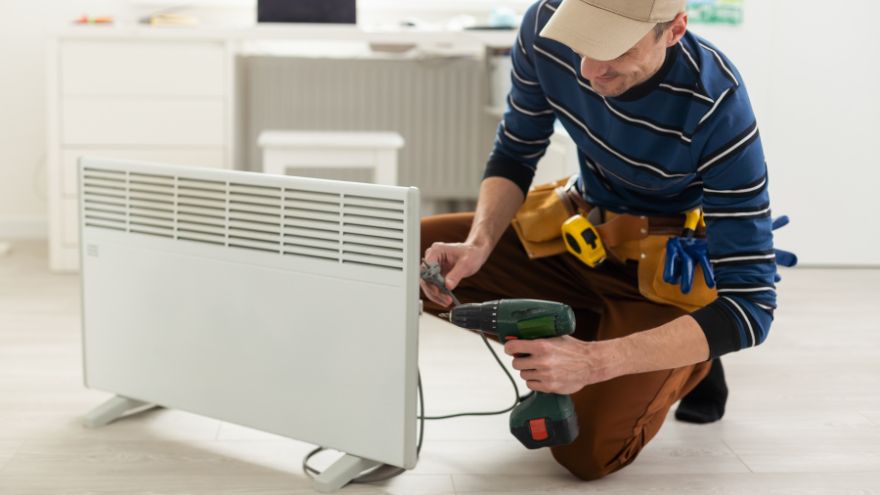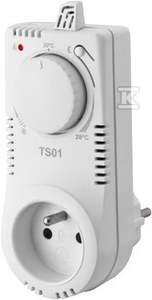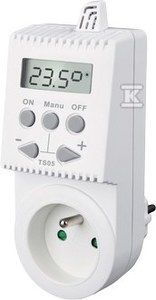Thermostats are used in many systems and installations. Their task is to control the temperature to prevent overheating, damage and failure. Currently, the controls are available in various variants. One of them is a socket thermostat. Where is it used, how to set it up correctly and can it be used with an electric heater?

Check out socket thermostats at the Onninen wholesaler
What is a socket thermostat?
A socket thermostat is one of the solutions used to precisely measure temperature and control heating in a room. The small-sized device simply plugs into a standard electrical socket and then connects the heating device to be controlled. Most often, these are electric heaters , although good quality models are also compatible with heating panels, oil heaters, infrared heaters or convector heaters.
Inside the thermostat there is a special air sensor whose task is to perform measurements. It provides information about the conditions in the room. Based on the data obtained, the device turns on or off according to the settings specified by the user.
Using a socket thermostat with an electric heater
 Although a socket thermostat is most often associated with heating a room, it also allows you to control cooling devices, such as air conditioners. Small socket thermostats allow for convenient and effective management of thermal comfort in rooms. Automatic control allows you to ensure optimal, set thermal conditions.
Although a socket thermostat is most often associated with heating a room, it also allows you to control cooling devices, such as air conditioners. Small socket thermostats allow for convenient and effective management of thermal comfort in rooms. Automatic control allows you to ensure optimal, set thermal conditions.
The use of a socket thermostat allows you to optimize the operation of the electric heater, as well as the costs associated with its use. If it were not for the programmed thermostat, the device would constantly heat the room, which is a very uneconomical solution. A thermostat located in the electrical socket allows you to control the operation of the device, and some available models also allow you to set the daily operating cycle of the device. Thanks to this, you can easily manage the heating and it will work according to your individual needs.
How to properly set a socket thermostat?
The method of setting the socket thermostat depends primarily on individual needs and the type of device. The models currently available for sale allow you to program the settings. In this way, you can not only rely on the sensor readings, but also set appropriate parameters according to your preferences, e.g. depending on the time of day. At night or when no one is home, you can program a lower temperature to optimize your heating costs.
Is it better to choose a socket or surface-mounted thermostat?
Currently, heating a house or a room allows you to optimize both thermal comfort and related expenses. There are various thermostat models to choose from. Some, such as bimetallic thermostats, operate effectively despite, for example, power failures, because the operating mechanism is based on completely different principles. In the case of a socket thermostat, electricity is necessary. However, a great convenience is the built-in mechanism that protects the device's memory and its settings in the event of a failure or sudden power loss.
 Surface-mounted thermostats are also very popular. Many models allow for equally convenient and effective heat management, and sensors measuring the room temperature control the system, heating the air until the desired temperature is reached, then turning off the room thermostats, still controlling the heat level. The greatest advantages of surface-mounted models include intuitive operation and the fact that they allow remote control.
Surface-mounted thermostats are also very popular. Many models allow for equally convenient and effective heat management, and sensors measuring the room temperature control the system, heating the air until the desired temperature is reached, then turning off the room thermostats, still controlling the heat level. The greatest advantages of surface-mounted models include intuitive operation and the fact that they allow remote control.
Wall-mounted thermostats are usually more technologically advanced models than models that plug into a regular electrical outlet. It is often also possible to connect them to advanced home management systems. The use of surface-mounted solutions allows you to remotely set the set temperature level, which is an excellent way to check the room temperature, etc.
The choice of the appropriate solution is best analyzed through the prism of individual needs and expectations, while taking into account the significant advantages and disadvantages of each variant. Surface-mounted thermostats are a more expensive solution compared to socket models that are designed to work with single heating devices. In turn, the lower price of socket thermostats allows you to control only one receiver at a time. Therefore, if there are more heating devices, it will be necessary to purchase additional devices.
Socket thermostats at the Onninen wholesaler
Convenient temperature control using a socket thermostat is a valued solution, especially since the available solutions are small and easy to use. The Onninen hydraulic wholesaler's assortment includes proven, high-quality solutions that can be used anywhere there are standard electrical sockets.
The simplest example is the Heat Decor TS-01 socket thermostat . This model allows you to easily control the operating temperature of the electric heater. The control is based on the measurement of the air temperature in the room, which is possible thanks to the built-in sensor. The temperature is set manually thanks to a special knob. The big advantage is its small size and the ability to work not only with an electric heater, but also with a convector, oil or infrared heater, and even a heating panel.
A more modern solution is the Heat Decor TS-05 socket thermostat . This is a model designed to work with an electric heater. Like the TS-01, it is equipped with an air temperature sensor, but instead of a knob it has functional buttons and a clear display. In TS-05, you can conveniently turn on or turn off the thermostat located in the electrical socket thanks to convenient buttons.
Onninen's offer also includes the Heat Decor TS-10 socket thermostat . Unlike previous proposals, TS-10 can be programmed with up to 4 temperature changes. Many advantages include the fact that the device can be programmed to work differently on every day of the week. The built-in modes include two operating variants - comfortable and economical. For those who prefer manual operation, the manual temperature control function has been left, so there is no need to use the built-in programmer.